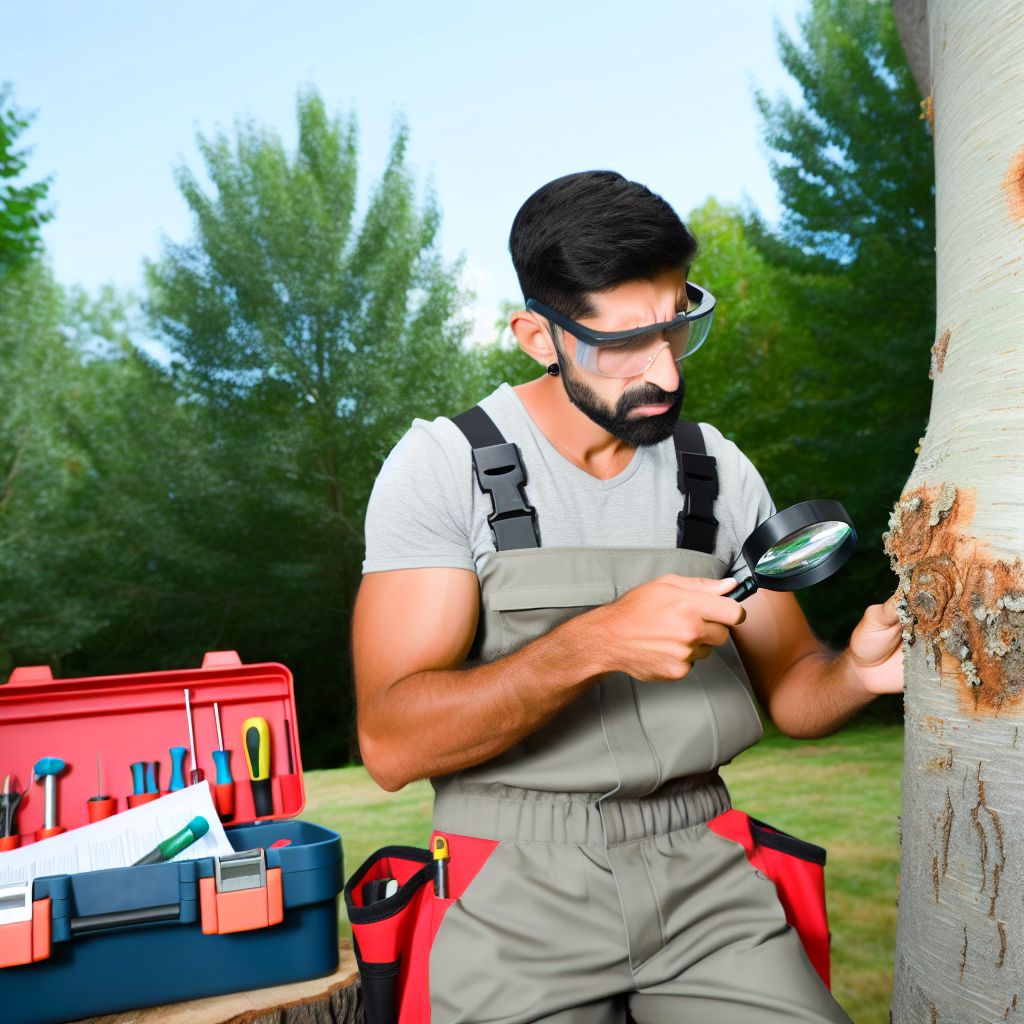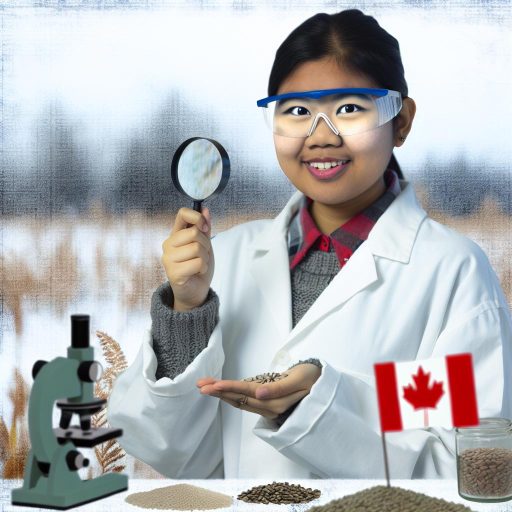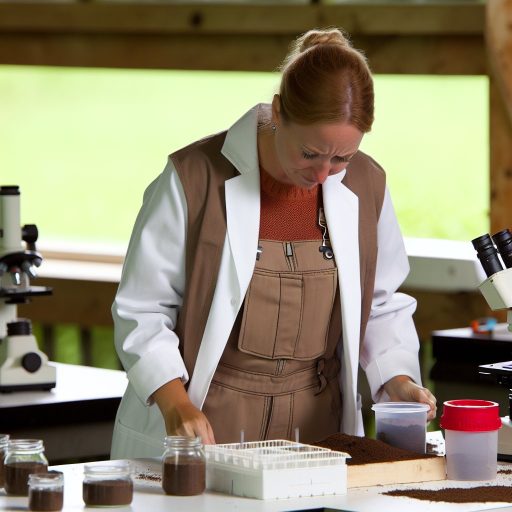Introduction to Arboristry and Importance of Tree Health
Arborists play a crucial role in maintaining tree health.
They study trees, identify diseases, and provide proper care.
Understanding tree health is essential for urban and rural environments.
Healthy trees enhance our landscapes and improve air quality.
Additionally, they provide habitat for numerous species.
Tree diseases can be caused by various factors, including pests and environmental stress.
Therefore, arborists must recognize symptoms promptly.
They use specialized techniques to diagnose issues effectively.
Monitoring tree health regularly prevents the spread of diseases.
Moreover, it ensures trees live long and productive lives.
Arborists educate the public about tree care and disease prevention.
They emphasize actions that homeowners can take to protect their trees.
Understanding Tree Diseases
Tree diseases can manifest in several ways.
Common symptoms include wilting leaves, unusual growths, and discoloration.
An arborist assesses these signs carefully to determine the cause.
They categorize diseases into infectious and non-infectious types.
Infectious diseases are caused by pathogens, such as fungi and bacteria.
Non-infectious diseases often result from environmental factors.
The Role of Environmental Factors
Environmental factors significantly impact tree health.
Soil quality, moisture levels, and temperature all play crucial roles.
For example, drought can weaken trees and make them more susceptible to pests.
Likewise, poor soil nutrition can lead to growth issues.
Arborists often investigate these environmental factors during assessments.
Importance of Regular Tree Assessments
Regular tree assessments help identify health problems early.
Arborists recommend conducting assessments at least once a year.
Unlock Your Career Potential
Visualize a clear path to success with our tailored Career Consulting service. Personalized insights in just 1-3 days.
Get StartedDuring these assessments, they inspect tree structure and overall vitality.
They also look for signs of pest infestations or disease development.
By addressing problems early, arborists can implement effective treatments.
Common Tree Diseases and Their Symptoms
Champignon Fungus
Champignon fungus, known as Armillaria, affects many tree species.
This fungus causes root rot, leading to tree decline over time.
Symptoms include yellowing leaves and reduced growth.
Infected trees may also exhibit unusual mushroom growth at the base.
Powdery Mildew
Powdery mildew is a common fungal disease affecting various trees.
It appears as a white powdery coating on leaves and stems.
This disease thrives in warm, dry conditions, particularly in spring.
Infected trees may develop distorted leaves, impacting photosynthesis.
Leaf Spot
Leaf spot diseases can arise from different pathogens, including fungi and bacteria.
Infected leaves show brown or dark spots surrounded by yellow edges.
Severe infections can cause premature leaf drop, impacting tree health.
Regular inspections help detect leaf spot diseases early.
Oak Wilt
Oak wilt is a deadly fungal disease affecting oak trees.
Symptoms include wilting leaves, leaf discoloration, and branch dieback.
Infected trees often show early fall coloration in summer months.
Management strategies include prompt removal of infected trees.
Phytophthora Root Rot
Phytophthora root rot is caused by water mold pathogens.
This disease leads to root dying, ultimately causing tree decline.
Symptoms include stunted growth and yellowing leaves in the tree.
Preventing waterlogging is crucial for managing this disease.
Steps Arborists Take to Diagnose Tree Diseases
Initial Observation
Arborists begin by examining the tree’s overall condition.
They look for visible signs of distress.
Common indicators include discolored leaves and abnormal growth patterns.
They also check for physical damage from pests or storms.
Identifying Symptoms
Next, arborists identify specific symptoms present on the tree.
They take note of any wilting, yellowing, or falling leaves.
Moreover, they inspect the bark for cracks or visible lesions.
Soil Assessment
Analyzing soil conditions is crucial for accurate diagnosis.
Arborists test soil pH and moisture levels.
They also examine nutrient availability to the tree.
Healthy soil supports tree strength and resilience.
Pest and Disease Analysis
Arborists investigate potential pest infestations.
They look for signs of insects such as holes or webbing.
Additionally, they identify any notable fungal growths.
Determining the presence of diseases is essential.
Laboratory Testing
Sometimes, arborists collect samples for laboratory analysis.
They may test leaf or bark samples for pathogens.
This step helps confirm any suspected diseases.
Developing a Treatment Plan
Once diagnosed, arborists create a tailored treatment plan.
They consider various factors, including tree species and severity.
Common treatments include fertilization, pruning, or pesticide application.
Collaboration with local experts may also occur.
Monitoring Progress
After treatment, monitoring the tree’s recovery is important.
Arborists conduct follow-up visits to assess improvements.
Adjustments to the treatment plan may be necessary.
Ongoing observations ensure long-term health for the tree.
Find Out More: Career Benefits of Pursuing Soil Science in Canada
Tools and Techniques Used by Arborists for Disease Diagnosis
Visual Inspection
Arborists often start with a visual inspection of the tree.
This initial assessment helps identify visible symptoms of disease.
Common signs include discolored leaves, unusual growths, or bark abnormalities.
Professionals look for patterns that may indicate specific issues.
Consequently, a thorough inspection informs further diagnostic steps.
Soil Testing
Soil health plays a critical role in tree vitality.
Arborists collect soil samples to analyze pH and nutrient levels.
This data helps identify deficiencies that may contribute to disease.
Furthermore, testing can reveal harmful pathogens in the soil.
Thus, soil testing provides essential information for effective treatment.
Microscopic Examination
Some tree diseases manifest at a microscopic level.
Arborists may use microscopes to examine infected tissues.
This technique allows for accurate identification of pathogens.
Moreover, identifying pests like fungi and bacteria aids diagnosis.
Ultimately, microscopic examination ensures the right treatment is applied.
Lab Analysis
Advanced lab analysis is available for complex cases.
Arborists often send samples to specialized labs for diagnostics.
These labs can conduct DNA analysis to identify pathogens.
Additionally, they can perform tests for chemical imbalances.
Lab findings guide arborists in crafting effective treatment plans.
Use of Diagnostic Tools
Various diagnostic tools assist arborists in their assessments.
These tools include moisture meters and air samplers.
Moisture meters help evaluate root zone hydration levels.
Air samplers assess the presence of airborne pathogens.
Employing these tools enhances the accuracy of disease diagnosis.
Interviews and History Review
Gathering information from tree owners is also essential.
Arborists may interview property owners about tree history.
Previous treatments and observed changes provide valuable context.
Furthermore, understanding local environmental conditions can reveal risks.
This comprehensive approach aids in accurate diagnosis and management.
Learn More: Career Growth and Advancement for Canadian Soil Scientists
Role of Soil Health in Tree Disease Management
Importance of Soil Quality
Ssoil health plays a crucial role in tree disease management.
Healthy soil enhances nutrient availability to trees.
Additionally, it promotes beneficial microbial activity.
This microbial community helps suppress harmful pathogens.
Soil Structure and Drainage
Proper soil structure enhances root growth in trees.
Good drainage prevents waterlogged conditions that promote disease.
Tree roots require oxygen for healthy growth.
Poorly drained soils can lead to root rot and other diseases.
Nutrient Management
Balancing soil nutrients fosters tree resilience against diseases.
Key nutrients include nitrogen, phosphorus, and potassium.
Regular soil testing helps monitor nutrient levels.
Based on results, amendments can be applied effectively.
Soil pH Levels
Soil pH affects nutrient availability to trees.
Most trees thrive in slightly acidic to neutral soils.
Testing soil pH allows for necessary adjustments.
Liming can raise pH, while sulfur can lower it.
Organic Matter and Microbial Life
Incorporating organic matter improves soil structure and fertility.
It increases water retention and supports microbial life.
Healthy microfauna breaks down organic materials effectively.
This process releases essential nutrients for tree health.
Prevention Strategies
Implementing soil health practices can prevent tree diseases.
These include composting and crop rotation.
Avoiding excessive tilling maintains soil integrity.
Cover crops can prevent soil erosion and nutrient loss.
Monitoring and Maintenance
Regular monitoring of soil health is essential.
Observing tree health can indicate soil issues.
Adjusting management practices based on these observations is crucial.
This proactive approach helps maintain tree vitality.
Gain More Insights: How Seed Technologists Ensure Food Security in Canada
Treatment Options for Tree Diseases: Chemical vs. Organic Solutions
Understanding Chemical Solutions
Chemical treatments often target specific tree diseases efficiently.
Pesticides and fungicides can help control various pathogens.
These solutions work quickly, offering immediate results.
However, they may pose risks to beneficial insects and the ecosystem.
Careful application is necessary to minimize unintended harm.
Application Methods for Chemicals
Applying chemicals can occur through several methods.
Foliar sprays deliver treatment directly to affected leaves.
Soil injections introduce substances into the root zone.
Granules can also provide slow-release options for long-term control.
Professional arborists ensure proper techniques are used for effectiveness.
Organic Solutions Overview
Organic treatments prioritize environmental health in tree care.
These methods focus on natural substances and processes.
Examples include neem oil and compost tea, which can enhance soil health.
Organic solutions can support the tree’s overall vitality over time.
Complementing Organic Options with Good Practices
Implementing good cultural practices complements organic treatments.
Proper watering and mulching strengthen tree immunity.
Ensuring proper spacing can improve air circulation around trees.
Regular inspections help identify issues before they escalate.
Comparing Effectiveness and Safety
Effectiveness varies between chemical and organic treatments.
Chemical solutions often show immediate results, whereas organic options may take longer.
In terms of safety, organic treatments tend to have less environmental impact.
They often support beneficial organisms and enhance soil quality.
Arborists prefer organic methods when long-term health is a priority.
Delve into the Subject: Innovations in Seed Technology for Sustainable Farming

Preventative Measures for Maintaining Tree Health
Regular Inspection
Regularly inspect your trees for signs of trouble.
Look for discolored leaves or unusual growth patterns.
Check for insect infestation, including spider mites and aphids.
By identifying issues early, you can address them promptly.
Proper Watering Practices
Water your trees deeply, ensuring roots receive adequate moisture.
Avoid overwatering, which can lead to root rot.
Use mulch to retain moisture and regulate soil temperature.
Monitor weather conditions to adjust watering accordingly.
Soil Health Enhancement
Healthy soil supports robust tree growth.
Perform soil tests to assess nutrient levels and pH balance.
Add organic matter, such as compost, to improve soil quality.
Avoid compaction around tree roots by maintaining a buffer zone.
Pruning Techniques
Pruning encourages healthy growth and reduces disease risk.
Remove dead, damaged, or diseased branches carefully.
Make clean cuts to avoid introducing pathogens.
Schedule pruning during late winter or early spring for best results.
Fertilization Programs
Develop a balanced fertilization program tailored to your trees.
Utilize slow-release fertilizers for sustained nutrient availability.
Monitor for nutrient deficiencies and adjust accordingly.
Optimize timing of fertilizer application to align with growth cycles.
Pest and Disease Management
Implement integrated pest management practices to protect trees.
Utilize natural predators to control pest populations.
Apply fungicides or insecticides when necessary, following label directions.
Regular monitoring helps identify outbreaks before they escalate.
Community Involvement
Engage your community to promote tree health awareness.
Host workshops on proper tree care techniques.
Encourage neighbors to share resources and educational materials.
Together, you can create a healthier environment for all trees.
Case Studies of Successful Tree Disease Treatments
Identifying Oak Wilt in Urban Areas
Oak wilt presents a serious threat to urban oak trees.
In one case, an arborist named Sarah Miller discovered infected trees in a city park.
She noticed wilting leaves and browning leaf edges on several oak trees.
After confirming her diagnosis, she took immediate action.
First, she removed the infected trees to prevent further spread.
Next, she applied a protective fungicide to nearby healthy oaks.
Fortunately, her efforts led to the preservation of many valuable trees.
This case highlights the importance of early detection and swift response.
Managing Cedar-Apple Rust
Cedar-apple rust affects both cedar and apple trees.
In a rural setting, arborist Tom Hughes faced this issue in a local orchard.
He identified the yellow-orange spots on the leaves as a telltale sign.
To treat the infection, he offered localized fungicide applications.
Additionally, he advised the orchard owner to remove nearby junipers.
This recommendation aimed to interrupt the disease cycle.
Thanks to his guidance, the orchard saw a significant recovery the following season.
Following this case, many local orchards adopted preventative measures.
Tackling Dutch Elm Disease
Dutch elm disease poses a daunting challenge for urban foresters.
In a small town, arborist Lisa Rodriguez encountered this invasive threat.
She discovered the disease in several mature elm trees along the main street.
After confirming her diagnosis, she organized a community awareness campaign.
She educated residents about the signs of the disease and prevention methods.
Moreover, she recommended removing and destructing infected trees promptly.
This proactive approach reduced the spread of the disease significantly.
Within a few years, the town’s elm population began to thrive again.
Controlling Aphid Infestations
Aphids can quickly devastate a variety of trees and shrubs.
In another successful case, arborist Mark Johnson addressed an infestation in a botanical garden.
He noticed curling leaves and excessive sticky residue on several species.
After assessing the situation, he implemented integrated pest management techniques.
Using natural predators, he successfully controlled the aphid population.
Moreover, he introduced regular monitoring practices for early detection.
Consequently, the botanical garden maintained its health and beauty.
This approach emphasizes the effectiveness of eco-friendly pest control methods.
The Importance of Professional Arborist Intervention
Professional arborists possess specialized knowledge of tree biology.
They are trained to identify various tree diseases accurately.
This expertise ensures appropriate diagnosis and treatment plans.
Effective Treatment Options
Arborists utilize effective treatment methods for tree diseases.
They may recommend pruning to remove infected branches.
In some cases, they apply fungicides to combat fungal infections.
Moreover, fertilization improves tree health and resilience.
Preventing Future Issues
Routine maintenance by arborists prevents future tree diseases.
They offer guidance on proper watering and soil care practices.
Additionally, arborists educate homeowners on pest management.
Environmental Impact
Healthy trees contribute significantly to the environment.
They improve air quality and provide habitat for wildlife.
By treating tree diseases, arborists enhance urban ecosystems.
Community Wellbeing
Investing in tree health enriches community landscapes.
Thriving trees enhance property values in residential areas.
Moreover, vibrant greenery promotes mental well-being among residents.
Additional Resources
Invasive Species: Hemlock Woolly Adelgid
Hiring a Certified Arborist | Extension | West Virginia University




